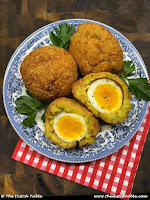Contrary to other snacks, like the frikandel, the eierbal can not be found everywhere and seems to be specific to Groningen and surrounding areas. There is one place, in Venlo, Limburg, that claims to have been the originator of the treat, but the proprietor lived in Groningen for a while so possibly got her inspiration there.
So how did this deep-fried egg ball happen to be in Groningen? I am glad you asked! During WW1, the Netherlands was neutral and provided a safe location for many English soldiers who were fleeing from the Germans in Belgium. They were interned in a camp in Groningen, named Timbertown. Up to 1,500 soldiers were housed here at one time.
 |
| Photo source: Friends |
It is very, very possible that these men also made Scotch eggs, seeing as how the Scotch egg was already known for several centuries in England. As they were also in contact with the locals, it is easy to see how the idea of wrapping boiled eggs would have stuck.
Since then, the eierbal has nestled itself so deeply into the local tradition and culture, that the golden snack was added to the inventory of Immaterial Cultural Heritages in 2017. As it appears to have been around since the early 1900s until now, you can imagine that the recipe has developed: almost everybody has a favorite snackbar to get their eierbal fix, or makes the recipe slightly different, but they're all considered eierballen, and they're all considered a Groningen tradition.
I decided to make these after working on videos from Groningen for our YouTube channel. Many of you have commented on how much you enjoy the nostalgic throwbacks to older times, and see how our parents and grandparents lived. I was also making dinner at the time and decided to serve mine as a meat alternative with spinach stamppot. Not traditional, but delicious nonetheless!
I chose to make the most traditional version, those with a curry ragout, but if you're making kroketten or bitterballen one of these days, you may try it also with a meaty ragout to see if you like it or substitute the curry powder with Mediterranean herbs, or something else you favor. I can also see where falafel seasoning would go well. You can also brush the egg with flavorings (sweet chili sauce, or mustard), so this recipe is perfect for turning it into a family exclusive!
Groningse Eierbal
4 eggs3 1/2 tablespoons butter (50 grams)
1/2 cup flour (100 grams)
2 cups vegetable or chicken bouillon (450 ml)
2 1/2 teaspoons curry powder
2 tablespoons chopped fresh parsley
1 egg
1 cup breadcrumbs or panko (50 grams)
2 tablespoons flour
Oil for frying |

